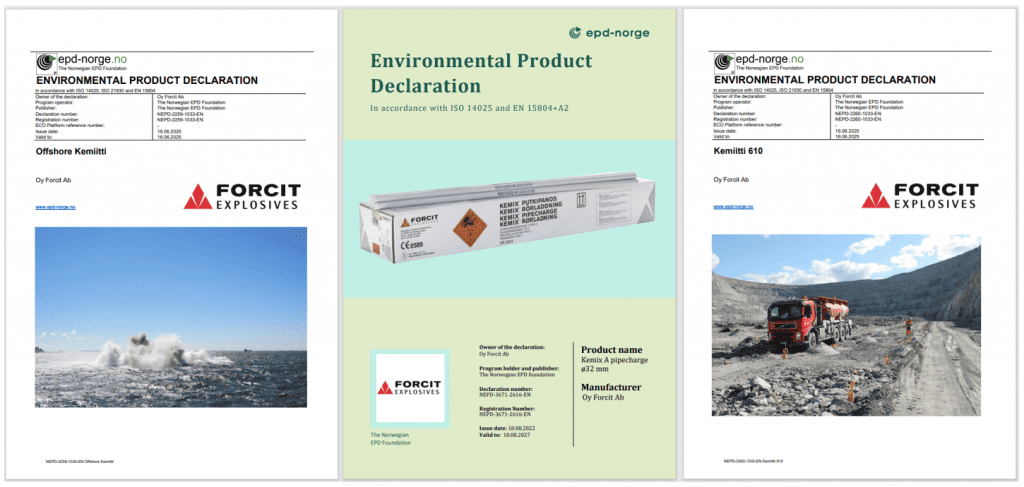Environmental Product Declarations in Blasting
Environmental Product Declarations (EPDs) for blasting operations, covering items such as bulk emulsions, cartridges, packaged explosives, detonators, cords, and other accessories, provide detailed and verified information on the environmental impact of these products across their entire life cycle. These declarations encompass various stages, including raw material extraction, manufacturing processes, transportation, use in blasting activities, and end-of-life disposal or recycling. By utilizing life cycle assessment (LCA) methodologies, EPDs offer comprehensive insights into the environmental footprint associated with each component of blasting operations. This transparency enables people to make informed decisions, promoting sustainability and responsible environmental management within the industry.

Key Aspects in Environmental Product Declarations
Environmental product declarations have been around since the 1990s, gaining prominence as a tool for promoting environmental sustainability in product design and procurement. There are several aspects to get the best understanding of them such as:
| Key Aspect | Explanation |
| Life Cycle Assessment (LCA) | EPDs are founded on the principles of LCA, which evaluates the environmental impacts of a product or service throughout its entire life cycle, from raw material extraction to end-of-life disposal or recycling. This holistic approach ensures that EPDs consider all stages of a product’s life, including production, transportation, use, and disposal. |
| Environmental Impact Categories | EPDs typically assess a range of environmental impact categories, such as greenhouse gas emissions, energy consumption, water usage, acidification, eutrophication, and resource depletion. These categories provide a comprehensive view of a product’s environmental footprint and help stakeholders understand its overall environmental performance. |
| Product Transparency | EPDs promote transparency by providing standardized and verified information about a product’s environmental performance. This transparency allows consumers, businesses, and other stakeholders to make informed decisions based on reliable data regarding the environmental impacts of products they use or procure. |
| Standardization | EPDs follow international standards such as ISO 14025 and EN 15804, ensuring consistency and comparability across different products and industries. This standardization facilitates the fair comparison of products within the same product category and enables organizations to benchmark their environmental performance against industry norms. |
| Functional Unit | EPDs express environmental performance relative to a functional unit, which represents the quantified performance of the product or service. This allows for meaningful comparisons between products with different characteristics or applications. |
| Data Quality and Verification | EPDs rely on accurate and reliable data to ensure the credibility of the information provided. |
Digitalization of Environmental Product Declarations
The digitalization of Environmental Product Declarations (EPDs) revolutionizes the accessibility and utility of sustainability information by offering dynamic, interactive formats that provide real-time updates, integration with databases and tools, standardization, data analytics, and life cycle assessment (LCA) integration. Through digital platforms, EPDs become readily available to a wider audience, ensuring not only the accuracy and timeliness of environmental performance metrics but also facilitates informed decision-making by enabling users to compare products, analyze data, and identify opportunities for sustainability improvement.

O-PitEco Green House Gas Emissions – O-Piteco (o-pitblast.com) is a platform that unites Environmental Product Declaration information with data coming directly from the field of blasting operations, making it possible, easy-to-use, and quick to have an environmental impact report of blasting operations, to compare products, analyze data, and identify opportunities for sustainability improvement. For more information, also check the latest case study conducted on Kevitsa, Boliden at NewsletterSummer23 copy





